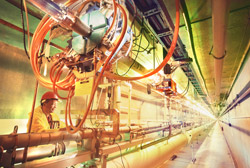How an accelerator works
Accelerators were invented to provide energetic particles to investigate the structure of the atomic nucleus. Since then, they have been used to investigate many aspects of particle physics. Their job is to speed up and increase the energy of a beam of particles by generating electric fields that accelerate the particles, and magnetic fields that steer and focus them.
 An accelerator comes either in the form of a ring (circular accelerator), where a beam of particles travels repeatedly round a loop, or in a straight line (linear accelerator), where the beam travels from one end to the other. A number of accelerators may be joined together in sequence to reach successively higher energies, as at the accelerator complex at CERN.
An accelerator comes either in the form of a ring (circular accelerator), where a beam of particles travels repeatedly round a loop, or in a straight line (linear accelerator), where the beam travels from one end to the other. A number of accelerators may be joined together in sequence to reach successively higher energies, as at the accelerator complex at CERN.
The main components of an accelerator include:
- Radiofrequency (RF) cavities and electric fields – these provide acceleration to a beam of particles. RF cavities are located intermittently along the beam pipe. Each time a beam passes the electric field in an RF cavity, some of the energy from the radio wave is transferred to the particles.
- Vacuum chamber – this is a metal pipe (also known as the beam pipe) inside which a beam of particles travels. It is kept at an ultrahigh vacuum to minimise the amount of gas present to avoid collisions between gas molecules and the particles in the beam.
- Magnets – various types of magnets are used to serve different functions. For example, dipole magnets are usually used to bend the path of a beam of particles that would otherwise travel in a straight line. The more energy a particle has, the greater the magnetic field needed to bend its path. Quadrupole magnets are used to focus a beam, gathering all the particles closer together (similar to the way that lenses are used to focus a beam of light).
Collisions at accelerators can occur either against a fixed target, or between two beams of particles. Particle detectors are placed around the collision point to record and reveal the particles that emerge from the collision.
An accelerator at home
A cathode ray tube (CRT) television set has the basic features of CERN’s accelerators. A filament inside the glass vacuum tube of the television set acts as a source of particles. When the filament is heated, electrons are set free by the increase in energy. The electrons are accelerated and guided through the vacuum of the CRT by an electromagnetic field, generated by a coil of wires. The television screen acts as a particle detector. As the high-energy electrons hit the back of the screen, they are detected and made visible in the colour pixels that make up the image.

